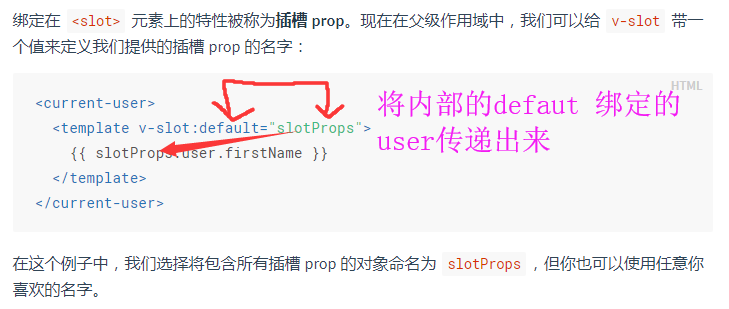在 2.6.0 中,我们为具名插槽和作用域插槽引入了一个新的统一的语法 (即 v-slot 指令)。
它取代了 slot 和 slot-scope 这两个目前已被废弃但未被移除且仍在文档中的特性。新语法的由来可查阅这份 RFC。
插槽内容:文字,html片段,其他组件,如果没有<slot> 插槽,那么其中的任何内容都会被扔掉
<navigation-link>//组件内容
<a v-bind:href="url" class="nav-link" > <slot></slot> </a>
<navigation-link url="/profile"> Your Profile </navigation-link> 这样渲染成
//其他任何模板代码 <navigation-link url="/profile"> <!-- 添加一个 Font Awesome 图标 --> <span class="fa fa-user"></span> Your Profile </navigation-link>
<a url="/profile" class="nav-link" >
<span class="fa fa-user"></span>
Your Profile
</a>
编译作用域:本页面的作用域,不能访问navigation-link内部作用域
父级模板里的所有内容都是在父级作用域中编译的;
子模板里的所有内容都是在子作用域中编译的。
<navigation-link url="/profile"> Logged in as {{ user.name }} //user 指向本页面作用域 </navigation-link>
后备内容:组件默认数据,你不传给我东西,我就展示自己数据!
有时为一个插槽设置具体的后备 (也就是默认的) 内容是很有用的,它只会在没有提供内容的时候被渲染。组件插槽 <button type="submit"> <slot>Submit</slot> </button>
具名插槽:<slot name="name"></slot>
<base-layout>组件 <div class="container"> <header> <!-- 我们希望把页头放这里 --> </header> <main> <!-- 我们希望把主要内容放这里 --> </main> <footer> <!-- 我们希望把页脚放这里 --> </footer> </div>
1:一个不带name的<slot>出口会带有隐含的名字“default”。
2:在向具名插槽提供内容,用template v-slot
3:注意v-slot只能添加在一个<template>上
<base-layout> <template v-slot:header> <h1>Here might be a page title</h1> </template> <p>A paragraph for the main content.</p> <p>And another one.</p> <template v-slot:footer> <p>Here's some contact info</p> </template> </base-layout>
<base-layout> <template v-slot:header> <h1>Here might be a page title</h1> </template> <template v-slot:default> <p>A paragraph for the main content.</p> <p>And another one.</p> </template> <template v-slot:footer> <p>Here's some contact info</p> </template> </base-layout>

作用域插槽:让插槽内容能够访问子组件中才有的数据
有时让插槽内容能够访问子组件中才有的数据是很有用的
只有 <current-user> 组件内可以访问到 user 而我们提供的内容是在父级渲染的。

绑定在 <slot> 元素上的特性被称为插槽 prop。现在在父级作用域中,我们可以给 v-slot 带一个值来定义我们提供的插槽 prop 的名字:

独占默认插槽的缩写语法:
这种写法还可以更简单。就像假定未指明的内容对应默认插槽一样,不带参数的 v-slot 被假定对应默认插槽
注意默认插槽的缩写语法不能和具名插槽混用,因为它会导致作用域不明确:
<current-user v-slot:default="slotProps"> {{ slotProps.user.firstName }} </current-user>
<current-user v-slot="slotProps"> {{ slotProps.user.firstName }} </current-user>
出现多个插槽,请为所有插槽使用完这个的template语法 <current-user> <template v-slot:default="slotProps"> {{ slotProps.user.firstName }} </template> <template v-slot:other="otherSlotProps"> ... </template> </current-user>
解构插槽 Prop:作用域插槽组件数据传递出来,内部工作原理是将你的插槽内容包括在一个传入单个参数的函数里
这个地方看得有点蒙圈!
function (slotProps) { // 插槽内容 }
动态插槽名:
<base-layout> <template v-slot:[dynamicSlotName]> ... </template> </base-layout>
具名插槽的缩写:v-slot:header 缩写为#header,必须有name
<base-layout> <template #header> <h1>Here might be a page title</h1> </template> <p>A paragraph for the main content.</p> <p>And another one.</p> <template #footer> <p>Here's some contact info</p> </template> </base-layout>
该缩写只在其有参数的时候才可用。这意味着以下语法是无效的 <!-- 这样会触发一个警告 --> <current-user #="{ user }"> {{ user.firstName }} </current-user> <current-user #default="{ user }"> {{ user.firstName }} </current-user>